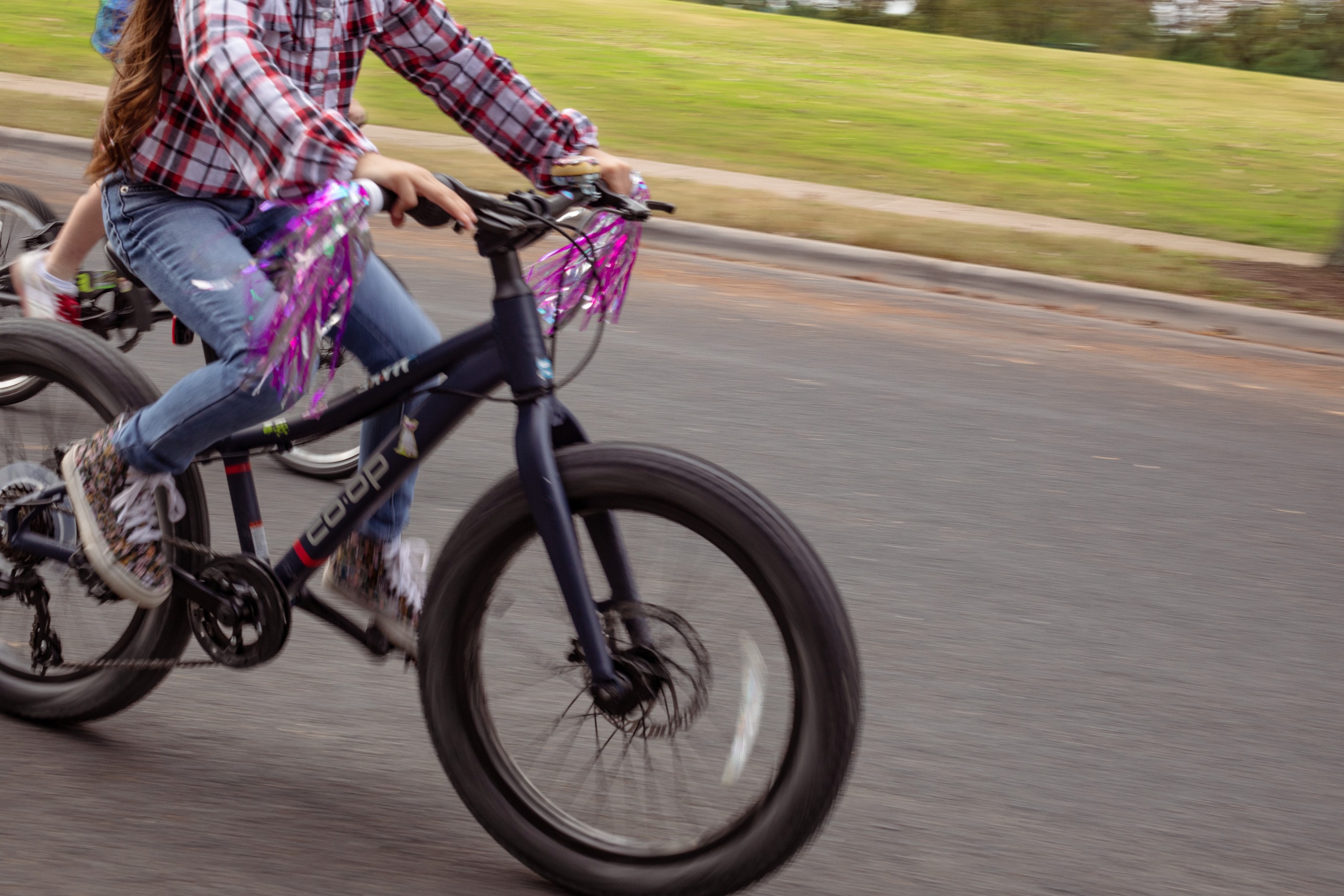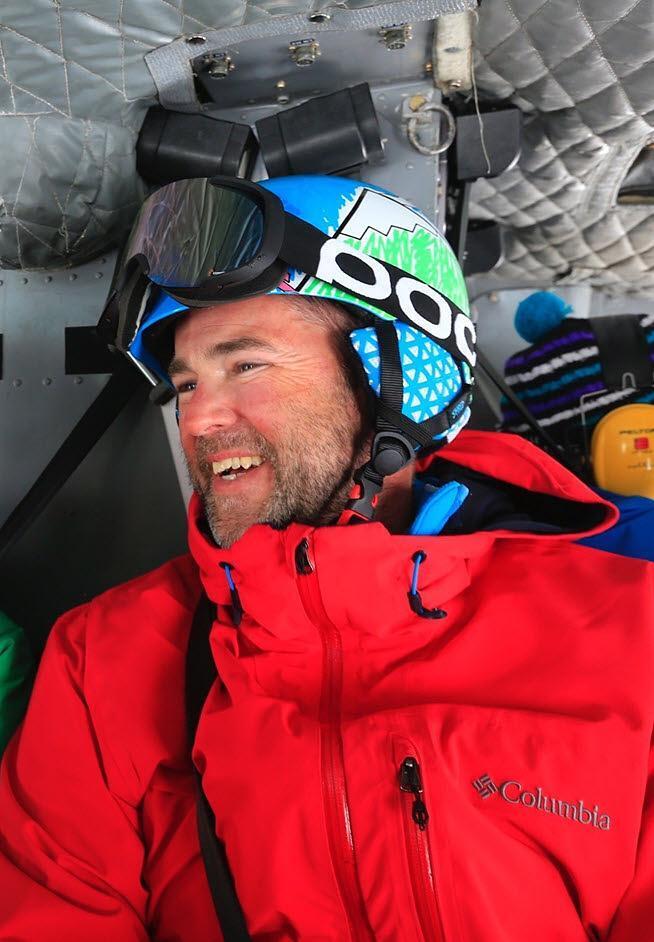From balance bikes for the smallest riders to youth mountain bikes with front suspension, there are a lot of two-wheel options available to young cyclists. But with so many choices, how do you narrow your search for the perfect kids' bike? We'll walk you through key decisions to help you find the right kids' bike.
This article covers:
For this guide, we talked to experts, including Co-op Cycles product manager Brian Kelly, product information specialist Ed Zebrowski and mom and former cycle editor Phuong Le, who has bought and swapped at least 10 kids' bikes over the past decade for her growing kids.
Editor’s note: We significantly updated this article on August 26, 2025, to include new and current subject matter expertise on kids' bikes, as well as new charts and links.
What size bike does my child need?
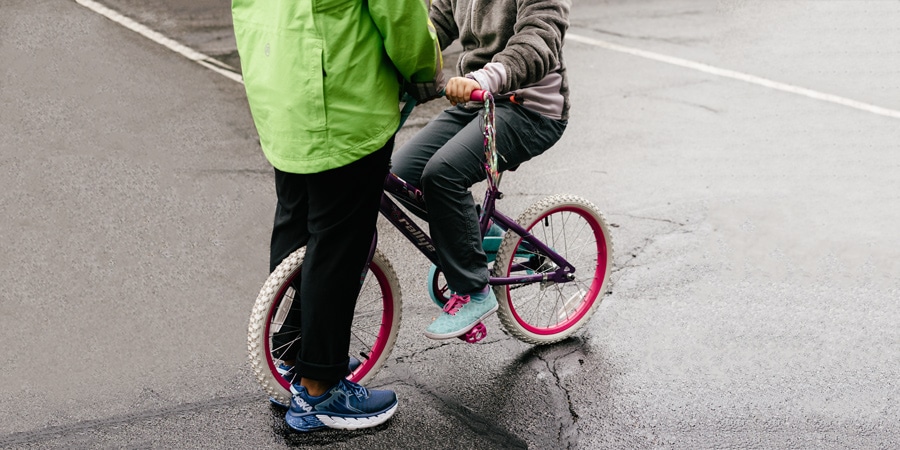
When sizing a kid for a bike, it’s best to start by measuring your child’s height and inseam (the length from their crotch to the floor). Age can provide a rough guide, but since kids grow at different rates, a size/inseam measurement will be more accurate. You'll use those measurements to narrow down your choices by bike wheel size.
To measure the child's inseam (or the inside leg length)
- Gather a large hardcover book or notebook, tape measure and pencil.
- Have the child stand against a wall.
- Put the book (spine up) between the child's legs.
- Use the pencil to mark where the spine of the book meets the wall. Measure from the mark to the floor. This is the inseam.
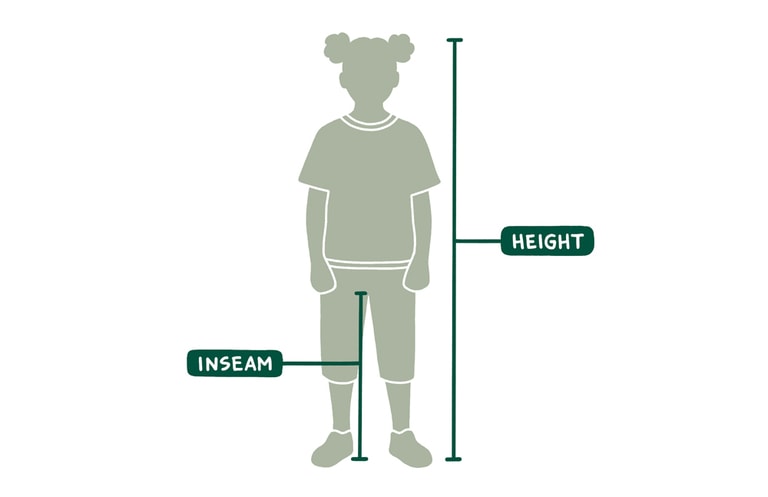
Once you have the inseam measurement, use the bike size chart guide below to find a suitable wheel size. For example, a child with a 16" inseam might fit both a 12-inch or an 14-inch bike.
The following chart is offered as a rough guide and shouldn't be a substitute for trying the bike out in person. Estimated age ranges are given here but keep in mind that age isn't a major determining factor when sizing a bike for a child because of the differences in kids' height, torso and legs within an age bracket. A bike that may fit one 7-year-old may be too big for another 7-year-old with shorter legs. Also, bikes with the same-size wheels may also vary in size between bike manufacturers.
Kids’ Bike Size Chart by Wheel Size
Bike Wheel | Height Range | Inseam Range | Age Range |
|---|---|---|---|
| 12-inch | 2'10"–3'4" | 14"–17" | 2–3 years |
| 14-inch | 3'1"–3'7" | 16"–20" | 3–4 years |
| 16-inch | 3'7"–4'0" | 18"–22" | 4–6 years |
| 20-inch | 4'0"–4'5" | 22"–25" | 5–8 years |
| 24-inch | 4'5"–4'9" | 24"–28" | 7–11 years |
| 26-inch | 4'9"+ | 28"+ | 10+ years |
Once you have a rough idea of the wheel size you need, have the child try several bikes out.
Pro tip: It's important to buy a bike that fits well now rather than one that is too large that they can "grow into." When a bike fits right, it's easier for kids to handle, safer and more fun to ride.
What are the different types of kids’ bikes?
There are four key types of bikes for kids. Here, we’ve arranged them roughly by experience level—from beginner to more advanced. However, some kids may skip certain types altogether.
Bike Type | Key Features | Wheel Sizes | Best For |
|---|---|---|---|
| 12 in., 14 in. | Teaching balance and steering to youngest kids | |
| 12 in., 16 in., 20 in. | Building confidence while learning to ride | |
| 14 in., 20+ in. | Riding on paved surfaces | |
| Typically, 20+ in. | Riding on trails and rough off-road terrain |
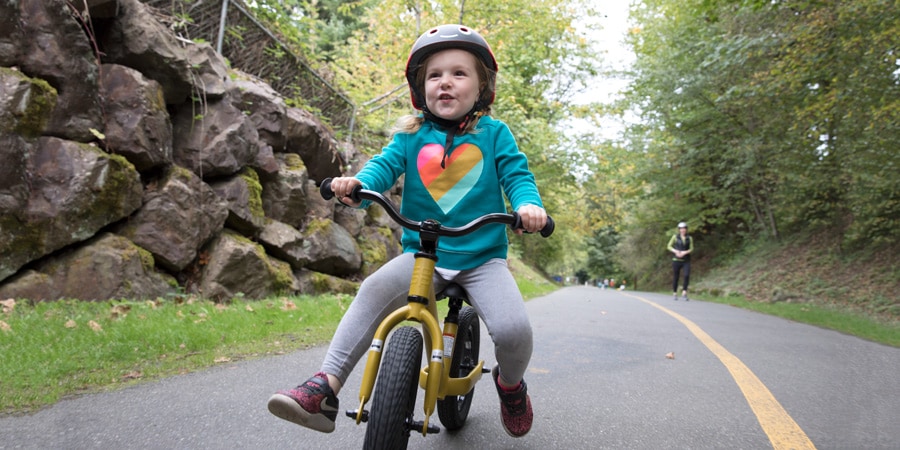
Kids’ Balance Bikes
These bikes have no pedals, crank or chain—just wheels, a seat and frame. As the child walks or scoots along, their feet act as brakes. Balance bikes are typically lighter and easier to handle than tricycles or training wheel bikes. They help kids learn to steer and balance without worrying about pedals. The better they get at it, the easier their transition to pedaling will be. Balance bikes are available in 12- and 14-inch wheel sizes. Bikes with these smaller wheel sizes purposely have low seats to make it easier for the child to put their feet down, which allows them to learn to balance and scoot.
Kids’ Training Wheel Bikes
Training wheel bikes feature two main wheels, one each in front and back, along with two smaller, removable wheels attached to the lower back part of the frame (the rear dropout). The training wheels provide additional stability and a confidence boost during the learning process. Since kids learn to bike at different ages, Co-op Cycles offers training wheel bikes in a range of wheel sizes: 12, 16 and 20 inches.
Kids’ Cruiser Bikes
Kids’ cruiser bikes are designed for comfort and ease of use on paved surfaces. They tend to have a more upright seating posture, simple frames and wide, relatively smooth tires. Models start at 14-inch wheel size, with larger sizes (often 20 inches and up) more likely to have gears. Most have handbrakes, though some also have coaster brakes. Cruiser bikes are best for kids who will primarily be riding on paved surfaces.
Kids’ Mountain Bikes
Kids’ mountain bikes are purpose-built for more rugged off-road terrain. The frame positions the rider in a less upright position, better suited for when the trail serves up unexpected obstacles. Knobby tires are designed for optimal traction on dirt, rocks, roots and other unpaved surfaces. Mountain bikes will have multiple gears (often six to nine), tend to be lighter weight (to make uphill sections easier), and may have more advanced braking systems like mechanical or hydraulic disc brakes. (More on this below.) Higher-end models may include suspension systems that dampen bumps and provide a smoother ride. As a result of these additional features, not to mention the beating they take on the trail, mountain bikes tend to require a bit more maintenance than their cruiser counterparts.
Read How to Bike with Young Kids and Bike Maintenance Basics for more tips.
How do I find the right type of bike for my child?
Deciding on the right type of bike for your child comes down to what kind of riding they will do.
Match the Bike to Riding Style and Terrain
All four types work well on paved terrain. Balance and kids’ training wheel bikes are ideal for beginners. Balance bikes, for example, are designed for tiny tots who perhaps have mastered walking and are ready for the next challenge. “When they’re young, a balance bike makes a ton of sense because it helps them get the feeling for it as far as gliding,” says Brian Kelly, product manager for Co-op Cycles. “The younger they are, the more likely it is that they’re going to enjoy a balance bike.”
Kids’ cruiser bikes suit just about any rider type, while children who will be riding regularly on less uniform paths, especially dirt or singletrack, or more advanced trails may be ready for a mountain bike. Read How to Choose a Bike for more information.
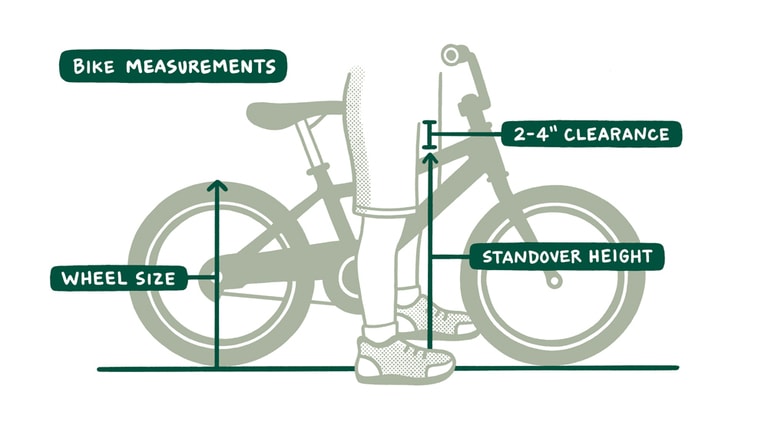
How do I know the bike fits my child?
Once you’ve narrowed your search to the right wheel size and bike style, it’s time to dial in the fit. Keep in mind that for beginners especially, nailing the fit is essential. “It’s easy to want [a bike that] they’ll ‘grow into,’” says REI product information specialist Ed Zebrowski, but for new riders especially, it’s “important to buy a bike that fits well so they can ride comfortably and confidently while they learn.”
- Assess the stand-over height. Have your child stand over the bike’s top tube with their feet on the ground. (The top tube is the upper bar that connects the seat post and saddle to the stem and handlebars). There should be about 2 to 4 inches of clearance between their crotch and the top of the tube.
- Next, review the seat height. Since kids’ bikes are often designed to facilitate a more upright position, they should be able to sit on the seat comfortably and see around them easily, Zebrowski says. Their legs should be slightly bent at the bottom of the pedal stroke.
- Lastly, look at their handlebar reach. Your child should be able to sit on the seat and easily grip the handlebars with just a slight bend in their elbows.
Signs It’s Time to Size Up
Keep these bike fit tips in mind as your child grows. They will help you know when it’s time to size up. The good news is that bikes in general—and kids’ bikes in particular—have numerous points of adjustability that should allow your young rider to get a season (or hopefully more) out of the bike.
Still, you’ll know that your kiddo is ready for a new bicycle when:
- There’s more than 4 inches of clearance between their crotch and the top tube.
- Their knees bend significantly or come close to the handlebars when pedaling.
- They look uncomfortably hunched over the handlebars rather than sitting more upright.
The best way to find the right fit is to take your kiddo bike shopping in person. In addition to building excitement around the process (what kid doesn’t want to shop for a new set of wheels?), shopping in-store will also allow your child to “try on” the bike before buying. Be sure to lean on the expertise of a knowledgeable salesperson like the ones found at your local REI Bike Shop. Read Bike Fitting Basics and Mountain Bike Fitting Basics for more information.
What features should I look for on a kids’ bike?
Kids’ bikes may have all the trimmings or just the essentials. Here’s a rundown of the different elements and features to consider during the buying process.
Weight and frame material
Lighter bikes are easier for kids to handle. As a rule, the bike should be no more than 30% to 40% of the child’s weight, Kelly says. Of course, there are exceptions, especially if your child is ready for add-ons like gears. One tip to save weight? Look for a kids’ bike with an aluminum frame, which is lighter than a steel frame. Brands like woom specialize in lightweight bikes.
Tires and traction
Wider tires offer more traction and comfort but add weight to the bike. The Co-op Cycles REV 20 is an REI staff favorite, partly because it features 2.25-inch-wide tires, which deliver better control than the skinnier tires found on others bikes this size. Mountain bikes like the Rocky Mountain Growler Jr 20 Kids' Mountain Bike also have wider, all-terrain tires for a smoother, stable ride. For more information about tire sizes, see How to Choose Bike Tires.
Pedals and training wheels
Once your child has mastered the balance of riding (perhaps on a balance bike), it’s time to introduce pedals. Usually, they’re ready for pedals at around age 4 or 5. In many cases, starting your kiddo on a balance bike will allow your family to skip the training wheel phase entirely. Read How to Teach a Child to Ride a Bike.
Brakes
- Coaster brakes, also called pedal brakes, stop the bike by preventing the rear hub from rotating when the child pedals backward. Coaster brakes tend to be easier for younger kids to use and require little maintenance. On the other hand, pedal brakes may confuse riders just as they’re getting accustomed to the pedaling motion, especially as they begin to stand on the pedals for more power, Kelly says.
- Handbrakes, which are located on the outer ends of the bike’s handlebars, engage when the child uses their hand to squeeze the lever. Some models have a single handbrake; while models for older/bigger kids may have two brakes. Both options require more hand strength to stop the bike. Models with two brakes also require a bit more coordination since one brake stops the front wheel, while the other brake stops the rear wheel.
- Since handbrakes will be the braking system on larger bike sizes, it may make sense to get the child accustomed to them earlier. Some kids’ bikes feature handbrakes with adjustable levers that better cater to smaller hands. With handbrakes, you’ll have three types of braking systems: mechanical, rim and hydraulic.
- Most kids’ bikes feature mechanical or rim brakes, which are easy to maintain and offer sufficient stopping power for most kids. Hydraulic brakes, which are more responsive but also require more work to maintain, are more common on bikes with 20-inch wheels/bikes for older kids. Read The Difference Between Rim Brakes and Disc Bike Brakes to better understand the pros and cons of different brake styles and How to Check and Adjust Bike Disc Brakes for maintenance tips.
Gears
- Single speed: Bikes without gears, also called single speed bikes, are simpler to use (no worrying about shifting up or down) and reduce weight in the bike. “Keeping it simple is never a bad [idea when] … they’re first learning to ride,” Kelly says. “It allows them to focus on pedaling and learning and balance. And they probably don’t need [gears] as much.” A single speed works fine for beginners as well as older riders generally covering flat terrain.
- Multiple gears: You start to see gears on kids’ bikes with 20-inch wheels and larger. Adding gears to a bike can help kids go longer distances and/or ride uphill more efficiently.
Adjustability
Choosing a bike with more adjustable components will likely mean your kiddo will be able to ride the same bike for longer. And good news: Just about all bikes will come with some level of adjustability built in. “Kids are going to grow,” Kelly says, “and bikes can generally grow with them up to a certain point.”
Look for adjustable seat height and handlebars, in particular. Some kids’ bikes also have extended seat posts and frames that offer even more room to grow.
Suspension for trail riding
Some kids’ mountain bikes come with front suspension, which to provides a little extra cushion when riding on bumpy trails. It will also add a bit of extra weight, complexity to the maintenance process and a jump in price.
How much should I spend on a bike?
It can be tempting to pinch pennies when purchasing a bike for your child (and buy a cheap bike at a mass retailer), but spending less often results in a heavier, less durable bike that’s harder to maintain—especially if retailer service options are limited. It’s also likely be less fun to ride, Kelly notes, and “if they’re not enjoying their time on [the bike], they’re not going to want to ride it.”
Quality vs. Cost
A high-quality, well-built bike from a reputable brand like woom, Cannondale and Co-op Cycles may cost anywhere from $250 to $600, depending on the size, features and other factors. Spending a bit more almost always means a winning combination of higher-quality components, a lighter frame, better fit, greater adjustability and a longer lifespan. (A more durable bike can be handed down to a younger sibling or friend.) And our team of bike experts note that well-maintained, good-quality bikes have higher resale value. “That means you can recoup some of the costs and put that toward your next kids’ bike,” says Phuong Le, an REI editor who has bought new and used, traded and passed at least 10 kids’ bikes since her kids first started scooting on balance bikes at age 2.
REI Co-op Member Perks and Services
Some bike retailers also include professional assembly and maintenance support. At REI, for example, every bike sold comes with free adjustments for one year after purchase date—as many times as you need. (Disclaimer: this includes derailleur and brake adjustments, lateral wheel truing, hub and headset bearing adjustments, tire inflation and chain lubrication; but it doesn't include replacement or installation of new components or accessories, any other services. Plus, members get additional perks, including a free Co-op Cycles bicycle tube with the purchase of any flat tire repair service (with the tube installed at the time of purchase), as well as a 20% discount on bike shop services.
Don't Forget the Accesories
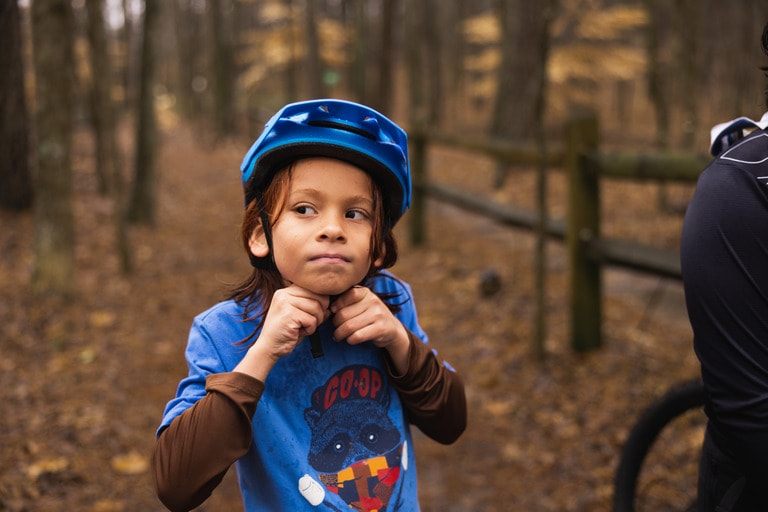
Safety essentials
Some kids’ bike accessories, like a helmet, are essential for keeping young riders and growing noggins protected in the event of a fall. It’s also wise to invest in a bell or horn, along with front and rear lights, to boost their visibility on the road or trail, thereby further upping the safety quotient. A bike lock, of course, will help to protect your investment.
Fun add-ons
Other accessories like a water bottle and cage, handlebar bag, pedals or even multicolored handlebar streamers will allow their personality to shine through. Plus, “anything that makes them excited about their bike,” Kelly says, “means that they’re all the more excited to ride.”
Our Experts
Of all the items Courtney Holden, contributing writer for Expert Advice and Uncommon Path, included on her baby registry, she was most excited about the green Strider bike. That was six kids’ bikes ago (including a Co-op Cycles ride). Her family of avid cyclists rides as much as possible—whether it’s cruising 2 miles to school or clocking 80 miles along the George S. Mickelson Trail. They’ve also welcomed many of their friends’ and family members’ babies into the world with a balance bike of their own.
Brian Kelly is a product manager with Co-op Cycles, the in-house bicycle brand at REI Co-op. He has been working on product strategy for nearly 20 years. At REI, he is responsible for developing product strategy for cycling gear, from kids’ bikes and gravel rides to cycle accessories. What started with a used bike for getting around in college led to years of building and tinkering with bikes—and ultimately to a role on the Co-op Cycles product team.
Phuong Le, managing editor of Expert Advice and former cycle editor, has spent more than a decade researching and scouting bikes for her two-wheeling kids. She has bought (new and used), sold, traded, or passed along to friends at least 10 kids’ bikes. Her kids first learned to scoot on Strider balance bikes at age 2, graduated to ultra-lightweight pedal bikes she ordered from the UK (before they became more widely available in the U.S.), and have since ridden multiple Co-op Cycles kids’ bikes.
